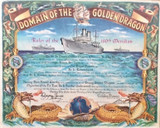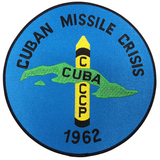Types of Military Patch Backing

When a military unit patch is manufactured, quite frequently it is created with the application in mind. Most patches are used on uniforms, or other types of apparel for display of the insignia, however many are also collected and placed in boxes or display cases to show off to those who care to view them. Once a manufacturer understands the practical application of where the patch will be used they can then adequately identify what type of backing should be used.
Sew On Backing
The majority of the time these items are embroidered, andthe embroidery process uses a special backing to keep structure and ensure proper sewing on the material. This backing is also used to keep the patch in place when sewing out within a tension hoop. However, this backing alone only allows for a patch to be sewn onto a garment and does not give the purchaser any other options for adhering to a surface. This backing can be made of dense cloth like fibers or plastic which gives a rigid feel. The plastic backing can be identified differently from iron on backing by feeling the embroidery stitches from the backside. The iron on backing will have the plastic feel all over, while the plastic backing won’t have any plastic showing on the backside where the stitches are filled in.
Iron On Backing
During the final process of the military patch production, it is very common to adhere a thin plastic to the back of the stitching which will melt and fuse to a surface when a moderate amount of heat is introduced. This can easily be accomplished using an iron or heat press. As such, this type of backing is commonly referred to as “iron-on backing”. Now, even though this method of attachment works wonderfully, many purchasers prefer to also sew on their patch after they have bonded the patch to their garment or accessory with the iron-on backing. This is by far the most secure way to attach a patch. May people refer to this type of backing as a hefty glue that is stable once cool.
Hook and Loop or Velcro Backing
The other common backing type is hook and loop or Velcro was invented in 1948 and subsequently patented. This method of attachment is formed by a series of small hooks on the patch that grab small loops of thread that is already attached to the garment. The hook and loop fastener has become a staple for many industries including shoes, garments, straps, and accessories. The Army officially adopted this method in 2004 for temporary placement of name tags and patches, and has been adopted to some measure throughout the military. A common shoulder patch is the United States Flag worn on the left shoulder, and a mirrored version worn on the right shoulder so that the flag always flies toward the back of the soldier signifying they are always moving forward and never retreating.
These three types of backing are the only types currently being used for military patches, but maybe some day there will be another invention that offers a better method that will rival the options we have discussed here. Until then figure out which type of backing suits your needs and purchase your patches accordingly.
Recent Posts
-
What is a Shellback in The Navy & How Are Individuals Initiated?
The Navy has its share of ceremonies and traditions that date back centuries in the western arena of …Jul 20th 2022 -
What is the Domain of the Golden Dragon & How Are Individuals Initiated?
The Domain of the Golden Dragon is type of highly coveted award granted to the crew members of the U …Sep 1st 2020 -
The Cuban Missile Crisis: Thirteen Most Dangerous Days of the Cold War
The Cuban Missile Crisis was a thirteen-day period during the Cold War where mankind came closestto …Aug 13th 2020




